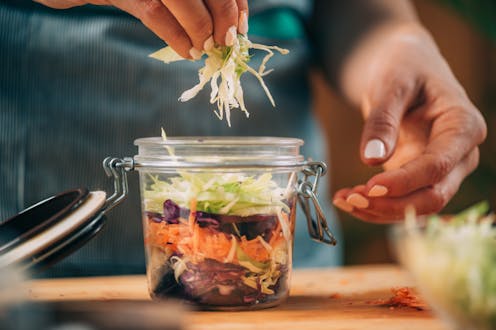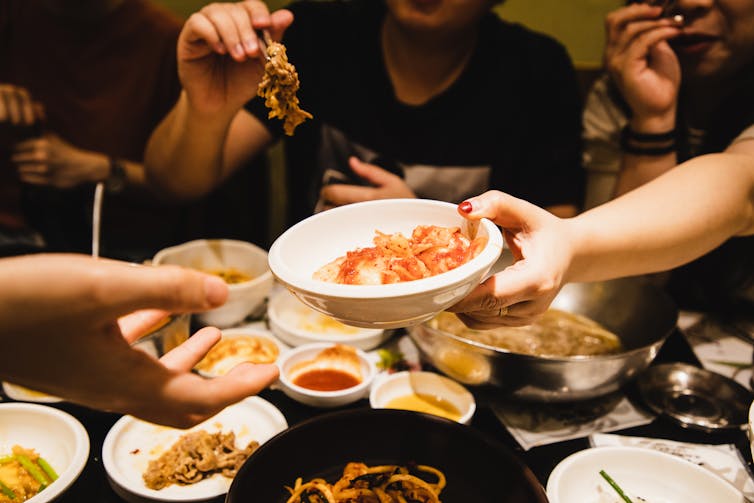Fermented foods sustain both microbiomes and cultural heritage
From kimchi to kombucha and sauerkraut to sourdough, many traditional food staples across cultures make use of fermentation. And these variations are reflected in your microbiome.

Many people around the world make and eat fermented foods. Millions in Korea alone make kimchi. The cultural heritage of these picklers shape not only what they eat every time they crack open a jar but also something much, much smaller: their microbiomes.
On the microbial scale, we are what we eat in very real ways. Your body is teeming with trillions of microbes. These complex ecosystems exist on your skin, inside your mouth and in your gut. They are particularly influenced by your surrounding environment, especially the food you eat. Just like any other ecosystem, your gut microbiome requires diversity to be healthy.
People boil, fry, bake and season meals, transforming them through cultural ideas of “good food.” When people ferment food, they affect the microbiome of their meals directly. Fermentation offers a chance to learn how taste and heritage shape microbiomes: not only of culturally significant foods such as German sauerkraut, kosher pickles, Korean kimchi or Bulgarian yogurt, but of our own guts.
Our work as anthropologists focuses on how culture transforms food. In fact, we first sketched out our plan to link cultural values and microbiology while writing our Ph.D. dissertations at our local deli in St. Louis, Missouri. Staring down at our pickles and lox, we wondered how the salty, crispy zing of these foods represented the marriage of culture and microbiology.
Equipped with the tools of microbial genetics and cultural anthropology, we were determined to find out.
Science and art of fermentation
Fermentation is the creation of an extreme microbiological environment through salt, acid and lack of oxygen deprivation. It is both an ancient food preservation technique and a way to create distinctive tastes, smells and textures.
Taste is highly variable and something you experience through the layers of your social experience. What may be nauseating in one context is a delicacy in another. Fermented foods are notoriously unsubtle: they bubble, they smell and they zing. Whether and how these pungent foods taste good can be a moment of group pride or a chance to heal social divides.
In each case, cultural notions of good food and heritage recipes combine to create a microbiome in a jar. From this perspective, sauerkraut is a particular ecosystem shaped by German food traditions, kosher dill pickles by Ashkenazi Jewish traditions, and pao cai by southwestern Chinese traditions.
Where culture and microbiology intersect
To begin to understand the effects of culinary traditions and individual creativity on microbiomes, we partnered with Sandor Katz, a fermentation practitioner based in Tennessee. Over the course of four days during one of Katz’s workshops, we made, ate and shared fermented foods with nine fellow participants. Through conversations and interviews, we learned about the unique tastes and meanings we each brought to our love of fermented foods.
Those stories provided context to the 46 food samples we collected and froze to capture a snapshot of the life swimming through kimchi or miso. Participants also collected stool samples each day and mailed in a sample a week after the workshop, preserving a record of the gut microbial communities they created with each bite.
The fermented foods we all made were rich, complex and microbially diverse. Where many store-bought fermented foods are pasteurized to clear out all living microbes and then reinoculated with two to six specific bacterial species, our research showed that homemade ferments contain dozens of strains.

On the microbiome level, different kinds of fermented foods will have distinct profiles. Just as forests and deserts share ecological features, sauerkrauts and kimchis look more similar to each other than yogurt to cheese.
But just as different habitats have unique combinations of plants and animals, so too did every crock and jar have its own distinct microbial world because of minor differences in preparation or ingredients. The cultural values of taste, creativity and style that create a kimchi or a sauerkraut go on to support distinct microbiomes on those foods and inside the people who eat them.
Through variations in recipes and cultural preferences toward an extra pinch of salt or a disdain for dill, fermentation traditions result in distinctive microbial and taste profiles that your culture trains you to identify as good or bad to eat. That is, our sauerkraut is not your sauerkraut, even if they both might be good for us.
Fermented food as cultural medicine
Microbially rich fermented foods can influence the composition of your gut microbiome. Because your tastes and recipes are culturally informed, those preferences can have a meaningful effect on your gut microbiome. You can eat these foods in ways that introduce microbial diversity, including potentially probiotic microbes that offer benefits to human health such as killing off bacteria that make you ill, improving your cardiovascular health or restoring a healthy gut microbiome after you take antibiotics.

Fermentation is an ancient craft, and like all crafts it requires patience, creativity and practice. Cloudy brine is a signal of tasty pickled cucumbers, but it can be a problem for lox. When fermented foods smell rotten, taste too soft or turn red, that can be a sign of contamination by harmful bacteria or molds.
Fermenting foods at home might seem daunting when food is something that comes from the store with a regulatory guarantee. People hoping to take a more active role in creating their food or embracing their own culture’s traditional foods need only time, water and salt to make simple fermented foods. As friends share sourdough starters, yogurt cultures and kombucha mothers, they forge social connections.
Through a unique combination of culture and microbiology, heritage food traditions can support microbial diversity in your gut. These cultural practices provide environments for the yeasts, bacteria and local fruits and grains that in turn sustain heritage foods and flavors.
Andrew Flachs receives funding from the Social Sciences and Humanities Research Council, Purdue University, the American Institute of Indian Studies, the United States Department of Education, the American Institute of Indian Studies, the Social Science Research Council, the Volkswagen Foundation, and the National Geographic Society.
Joseph Orkin receives funding from the Social Sciences and Humanities Research Council of Canada, the Natural Sciences and Engineering Research Council of Canada, the National Institutes of Health, and Université de Montréal
Read These Next
The Bible says little about Jesus’ childhood – but that didn’t stop medieval Christians from enjoyin
Legends about Jesus’ early years that circulated in medieval Europe often drew on apocryphal texts.
Sleep problems and depression can be a vicious cycle, especially during pregnancy − here’s why it’s
Inadequate sleep can have negative downstream effects on everyday cognitive functioning and mental health,…
How a niche Catholic approach to infertility treatment became a new talking point for MAHA conservat
Mainstream medical organizations have criticized ‘restorative reproductive medicine,’ but some Catholics…






